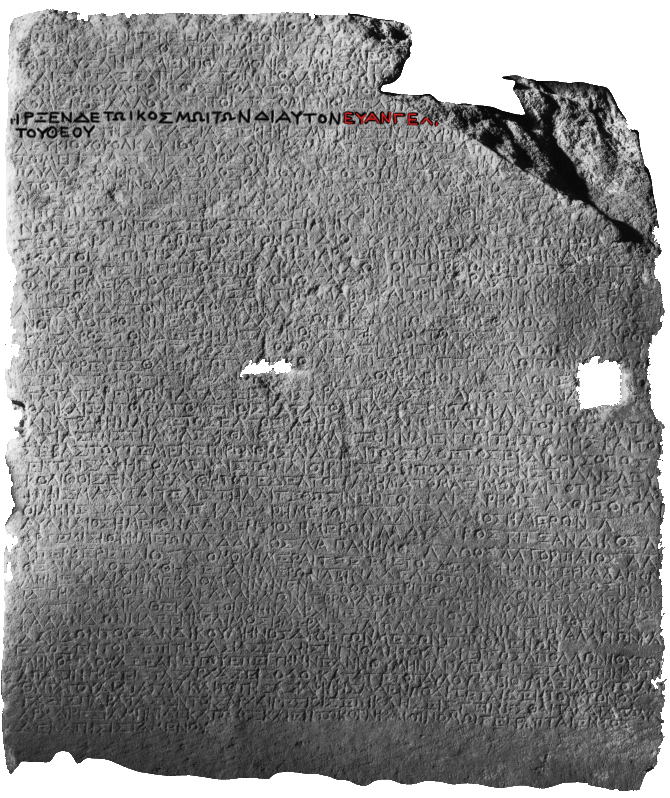
|
|
|
|
|
Artifact Analysis
|
|
|
|
- The Priene Calendar Inscription
-

This two-part tablet announces the intention of the city of Priene in western Turkey to change their calendar so that it begins on the birthday of the Roman Emperor Augustus in September. By doing this, they signal that, for them, time itself depends upon the beneficence of the new emperor. Near the top of tablet 2 (see the darkened lines to the right), they acknowledge Augustus as son of God whose birth marks the beginning of "good tidings" (ΕΥΑΝΓΕΛΙΟΝ) for the world. It was cut in 9 BCE, a few years before Jesus' birth.-
- The tablet demonstrates that the term "good tidings" or gospel was a political term before Paul or Mark—or perhaps Jesus himself—decided to use it in conjunction with the message of Jesus.
-
-
- Website
-
- Government Museums of Berlin - This is the artifact page for tablet 2 (lines 32-84) of Priene Inscription 105. The German title reads,
One (lines 32-84) of two stones of the labeled Ante of the Middle Exedra of the North Hall (Agora): Edict of proconsul Paul Fabius Maximus and decisions of the Hellenes of Asia to introduce a common calendar for the province of Asia (Asian calendar).
Decree (inscription / inscription genre)
Augustan [era]
More specifically, about 9 BCE
Location: Middle Exedra (Turkey / Priene / Agora / Holy Hall (Northern Hall of Agora))
Historical site: Middle Exedra (Turkey / Priene / Agora / Holy Hall (Northern Hall of the Agora))
Marble, light gray
Height: 84.2 cm
Width: 68 cm -69.7 cm
ID No. IvPri 105 II
Collection: Antique Collection
© Photo: Antique collection of the Staatliche Museen zu Berlin - Prussian cultural heritage
Photographer: Johannes Laurentius
-
- Bibliography
-
- Burrows, Millar. "The Origin of the Term 'Gospel.'" Journal of Biblical Literature 44:1-2 (1925) 21-33.
-
- Danker, Frederick W. Benefactor: Epigraphic Study of a Graeco-Roman and New Testament Semantic Field. St. Louis: Clayton, 1982. [See p. 217]
-
- Deissmann, Adolf. Excerpt from "Social and Religious History in the New Testament, Illustrated from the New Texts. Christ and the Caesars: Parallelism in the Technical Language of Their Cults." In Light from the Ancient East: The New Testament Illustrated by Recently Discovered Texts of the Graeco-Roman World, 2nd ed., trans. Lionel R. M. Strachan (New York: Hodder and Stoughton, 1911; original 1908) 370-371, and figs. 59–60.
-
- Dickson, John P. "Gospel as News: ευαγγελ- from Aristophanes to the Apostle Paul." New Testament Studies 51:2 (2005) 212-30.
-
- Dittenberger, Wilhelm. Orientis Graeci Inscriptiones Selectae, Supplementum Sylloges inscriptionum graecarum, 2 vols. (Leipzig, 1905) 2.48-60 (No. 458, and Inschriften von Priene No. 105).
-
- Evans, Craig A. "Mark's Incipit and the Priene Calendar Inscription: From Jewish Gospel to Greco-Roman Gospel." Journal of Greco-Roman Christianity and Judaism 1 (2000) 67-81.
-
- Mommsen, Theodor and Ulrich von Wilamowitz-Möllendorff. "Die Einführung des asianischen Kalenders." In Mittheilungen des Kaiserlich Deutschen archaeologischen Institutes, Athenische Abtheilung, vol. 24 (Athens: Barth & von Hirst, 1899) 275-293.
-
- Wendland, Paul. "Σωτηρ: Eine religionsgeschichtliche Untersuchung." Zeitschrift für die neutestamentliche Wissenschaft 5 (1904) 335-53. [See esp. 342-3, and n. 6]
-
-
|
|
|
|
|
